The Phoenix constellation is a minor constellation located in the southern celestial hemisphere. It was named after the mythical phoenix, which rose from its ashes upon death.
Key Facts & Summary
- The Phoenix constellation is among the 12 constellations created by Dutch astronomer and cartographer, Petrus Plancius.
- The Phoenix constellation was first depicted in 1598 and later appeared in Johann Bayer’s atlas – Uranometria, in 1603.
- Though the Phoenix constellation is small, in comparison to the other Plancius constellations, it is the largest.
- Among the 88 modern constellations, the constellation of Phoenix is the 37th largest constellation in the sky, stretching for around 469 square degrees.
- There are no Messier Objects in the constellation of Phoenix.
- Only two meteor showers are associated with the constellation of Phoenix, namely the December Phoenicids, and the July Phoenicids.
- The brightest star in Phoenix is Ankaa / Alpha Phoenicis, which has an apparent magnitude of 2.40.
- There are currently 10 stars in Phoenix that have been confirmed to host exoplanets.
- Some other interesting stars located in the constellation of Phoenix are Kappa, Mu, Beta, Nu, Gamma, Psi, SX, Rho, and BD Phoenicis, along with Wurren, Gliese 915, HD 142, HD 2039, WASP-18, WASP-4 and 5, WASP-29, and HE0107-5240, one of the oldest stars discovered.
- The constellation of Phoenix can be easily seen by anyone in Australia, and South Africa during summer.
- The constellation of Phoenix hosts many interesting deep-sky objects, such as the irregular dwarf galaxy NGC 625, the lenticular galaxy NGC 37, the group of galaxies known as Robert’s Quartet, the HLX-1 luminous source, which is the first discovered intermediate black hole, the gigantic Phoenix Cluster, or the largest distant galaxy cluster ever observed, the El Gordo, among others.
The constellation of Phoenix
The constellation of Phoenix is the largest Plancius constellation in the sky. It is part of the 12 constellations created by the famous Dutch astronomer and cartographer Petrus Plancius.

Plancius created the constellations based on the observations of Dutch navigators Frederick Houtman and Pieter Dirkszoon Keyser, in the late 16th century.
The constellation of Plancius was first depicted on a globe in 1598 and later appeared in Johann Bayer’s atlas Uranometria, in 1603. The Phoenix constellation represents the mythical bird that could revive out of its own ashes.

Location
The constellation of Phoenix is located in the southern celestial hemisphere. Phoenix is the 37th largest constellation in the sky, stretching for around 469 square degrees.
Phoenix is situated in the first quadrant of the southern celestial hemisphere (SQ1), and it can be seen at latitudes between +32o and -80o.
Anyone located in Australis or South Africa can see the constellation of Phoenix during summer. However, this constellation can’t be seen by anyone living north of the 40th parallel, as it lies low in the sky for observers north of the equator.
The best time to observe the stars and deep-sky objects located in the constellation of Phoenix is during the month of November when the constellation is the most prominent in the night sky.

- Right Ascension: 23h 26.5m to 02h 25.0m
- Declination: -39.31o to -57.84o
- Visible: between +32o and -80o.
- Best Viewed: at 21:00 (9 p.m.) during November
The constellation of Phoenix is bordered by the constellations of Eridanus, Grus, Fornax, Hydrus, Sculptor, and Tucana. Phoenix is part of the Johann Bayer family of constellations, along with Apus, Chamaeleon, Dorado, Grus, Hydrus, Indus, Musca, Pavo, Tucana, and Volans.

Notable Stars in the Constellation of Phoenix
The brightest star in the constellation of Phoenix is Ankaa / Alpha Phoenicis, which has an apparent magnitude of 2.40. Apart from Ankaa, there are many interesting stars located in the constellation of Phoenix, such as Kappa, Mu, Beta, Nu, Gamma, Psi, SX, Rho, and BD Phoenicis, along with Wurren, Gliese 915, HD 142, HD 2039, WASP-18, WASP-4 and 5, WASP-29, and HE0107-5240, one of the oldest stars ever discovered.
There are currently 10 stars in Phoenix that have been confirmed to host exoplanets.
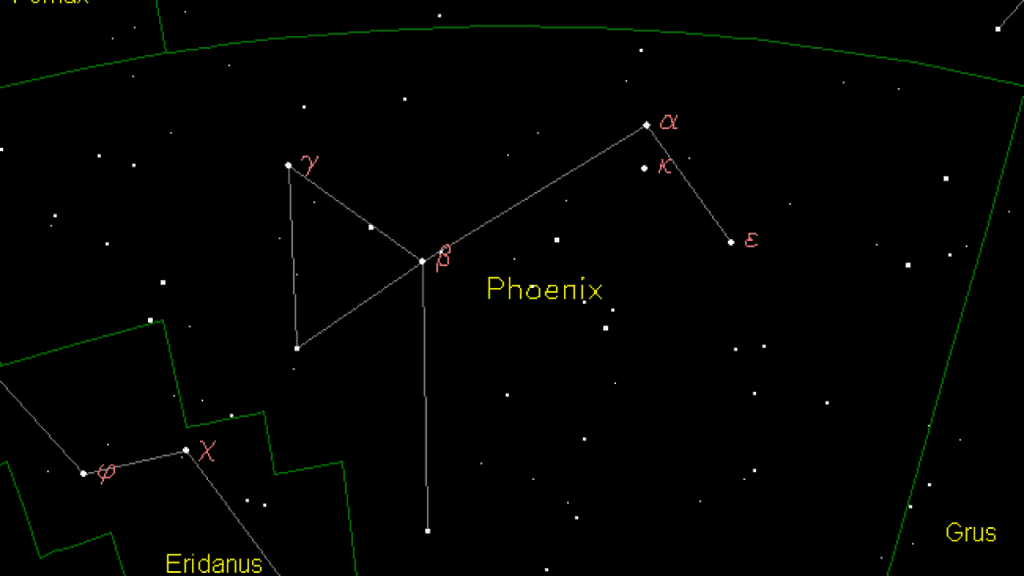
Ankaa
Ankaa, designated as Alpha Phoenicis, is the brightest star in the constellation of Phoenix, the celestial firebird. Ankaa has an apparent magnitude of 2.377, and an absolute magnitude of 0.52. It is located at around 85 light-years away from our Solar System.
Ankaa translates to “the phoenix” since it is derived from the Arabic “al-anqa”. This star is a spectroscopic binary system whose components orbit each other once every 10.5 years.

The primary star, Ankaa, is a K-type giant star that has around 1,500% of our Sun’s radius, thus it is around 30 times bigger than our Sun, and it has surface temperatures of around 4,436 K. It is thus cooler than our Sun.
Beta Phoenicis
Beta Phoenicis is a binary star system located at around 200 light-years away from Earth. The combined apparent magnitude of this star system is 3.30.
Beta Phoenicis is composed out of two G-type giant stars that are separated by almost one arcsecond. They orbit each other once every 170.7 years.

Gamma Phoenicis
Gamma Phoenicis is a star system located at around 233.6 light-years away from us. It has a combined apparent magnitude of 3.41. Only the primary star is visible within this system.
The primary star is a red giant that has around 130% of our Sun’s mass, and 5,000% of its radius, thus it is 100 times bigger than our Sun.

Gamma Phoenicis is 562 times brighter than our Sun, however, it is cooler, with surface temperatures reaching only 3,802 K. The only thing known about the secondary star orbiting Gamma Phoenicis, is that it has only 60% of our Sun’s mass.
Kappa Phoenicis
Kappa Phoenicis is an A-type subgiant star, which is part of the Castor Moving Group of co-moving stars. It is located at around 77.7 light-years away from us, and it has an apparent magnitude of 3.94.
Kappa Phoenicis is a fast-spinning star, having a rotational velocity of 245 km / 152.2 mi per second. This high rotational velocity has resulted in the star blowing off some of its material, and it is now encircled by a circumstellar disk of dust that extends for around 9 AU from the star.

Kappa Phoenicis has around 174% of our Sun’s mass, 203% of its radius, and it is 10.7 times brighter than our Sun. This star is also hotter than our Sun, with temperatures reaching 7,320 K. Its age has been estimated at around 348 million years, much younger than our Sun.
Wurren
Wurren, designated as Zeta Phoenicis, is a multiple star system located at around 300 light-years away from us. The star system is composed out of two B-type main-sequence stars, designated as Zeta Phoenicis A, and Zeta Phoenicis Aa, formally named Wurren.
The Zeta Phoenicis star system is an Algol-type eclipsing binary star, meaning that the two stars eclipse each other periodically, and thus their magnitude varies from 3.9 to 4.4, within 1,6 days.

Zeta Phoenicis A, the secondary star, has around 255% of our Sun’s mass, 185% of its radius, and it is 65 times brighter than our Sun, and twice as hot, with temperatures reaching 12,000 K.
Wurren, the primary star, has around 392% of our Sun’s mass, 285% of its radius, and it is 316 times brighter than our Sun. Wurren is also 2.4 times hotter than our Sun, with temperatures reaching 14,400 K.
Nu Phoenicis
Nu Phoenicis is an F-type main-sequence star located at around 49.5 light-years away from us. It has an apparent magnitude of 4.95, thus it is visible to the naked eye.
Nu Phoenicis has an iron abundance 45% greater than our Sun’s, and it is twice as bright. It is 17% more massive than our Sun, and its radius is 26% greater, while overall it is quite similar to our Sun.

SX Phoenicis
SX Phoenicis is a variable star, and the prototype star of the SX Phoenicis variables, which means it is a population II, high amplitude, pulsating variable.
SX Phoenicis is located at around 272 light-years away from us, and it has an apparent magnitude that varies from 6.76 to 7.53. It is a member of the galactic halo.

This star is just as massive as our Sun, however, its radius is 50% greater. SX Phoenicis is 5.89 times brighter than our Sun, and it is hotter, with temperatures reaching 7,684 K.
This star has low metallicity, with only 4% of the proportion of iron of the Sun. SX Phoenicis is classified as an A-type main-sequence star. The origin of SX Phoenicis, due to its peculiar velocity, and of SX Phoenicis variables in general, remains unclear.
HE0107-5240
HE0107-5240 is an extremely metal-poor population II star, located at around 36,000 light-years away from us. It has an apparent magnitude of 15.86.
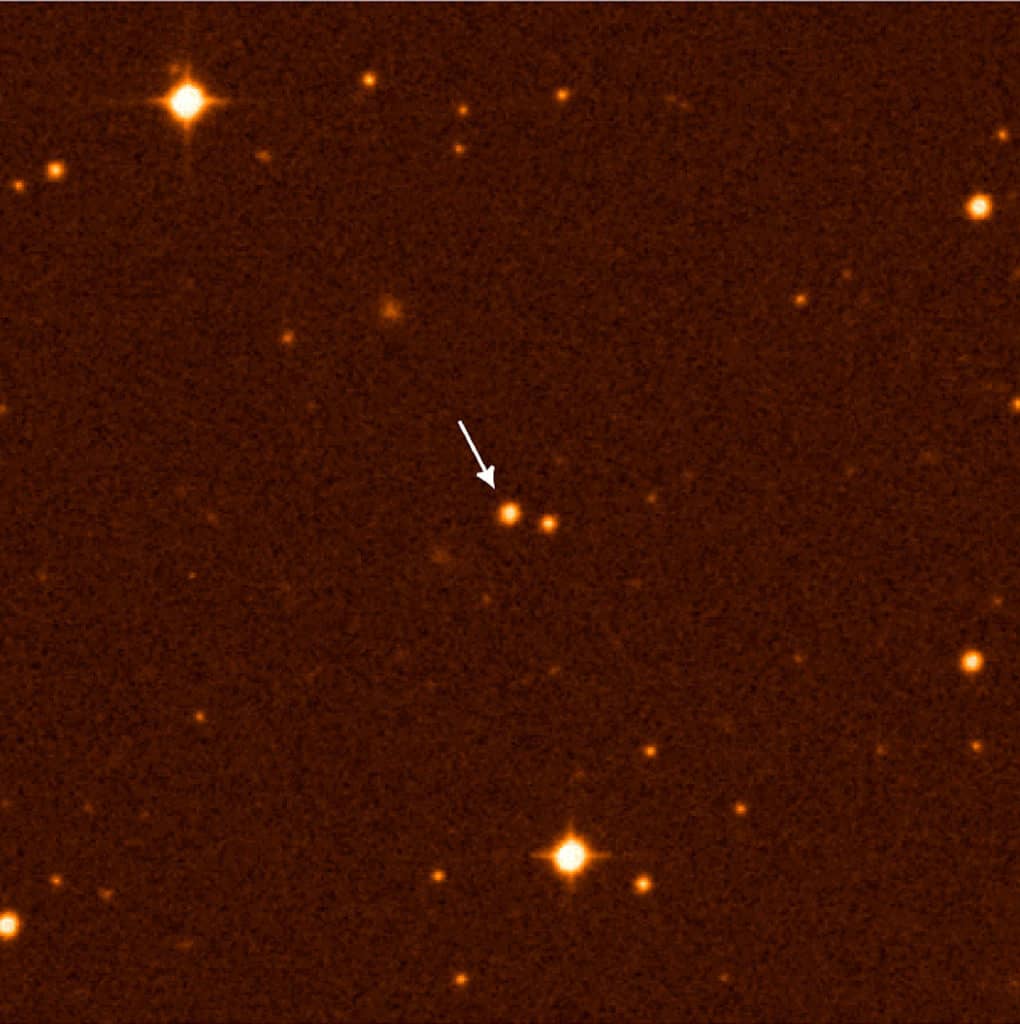
HE0107-5240 has only 80% of our Sun’s mass, and it is among the most metal-poor stars known in our galaxy. Thus, it is theorized that this star is among the oldest ever discovered, being around 13 billion years old.
Gliese 915
Gliese 915, also designated as WD 2359-434, is a white dwarf star, the nearest star to us from the Phoenix constellation, situated at just 26.7 light-years away.
Gliese 915 has only 85% of our Sun’s mass, 0.00097 solar radii, while its temperatures reach 8,570 K, thus it is hotter than our Sun. It is among the closest white dwarf to our Solar System.

Psi Phoenicis
Psi Phoenicis is a red giant star located at around 342 light-years away from us. It is a semiregular variable star, suffering brightness variations from magnitude 4.3 to 4.5 within a period of 30 days.
Psi Phoenicis has around 130% of our Sun’s mass, 8,600% of its radius, thus it is more than 160 times bigger than our Sun, and it is also 1,050 times brighter than our Sun.

HD 142
HD 142 is a wide binary star system located at around 85+ light-years away from us. The primary star has an apparent magnitude of 5.711, while the secondary +11.5.
The primary component is an F-type main-sequence star, that has around 125% of our Sun’s mass, 141% of its radius, and it is 2.9 times brighter. The primary star is also host to two discovered exoplanets.
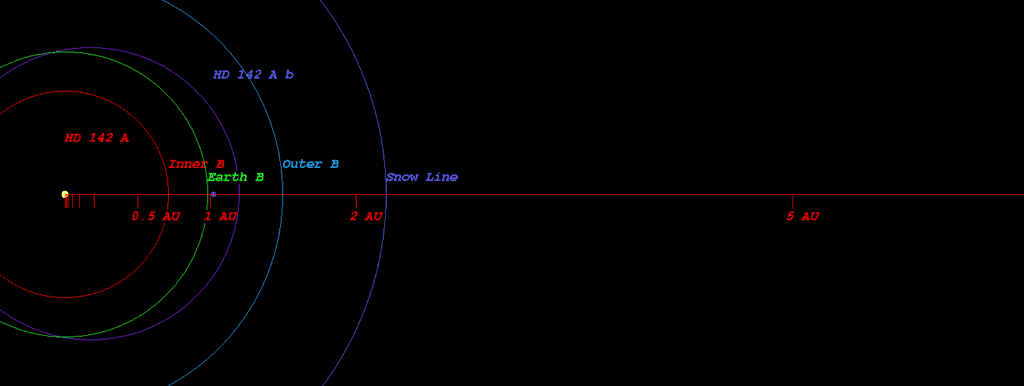
HD 2039
HD 2039 is a yellow subgiant star located at around 280 light-years away from us. It has an apparent magnitude of 8.99, and it also hosts an exoplanet.
HD 2039 is a G-type star that has around 120% of our Sun’s mass, 140% of its radius, and it is 2.18 times brighter than our Sun, though its temperature is similar.
The discovered exoplanet has a minimum mass more than four times that of Jupiter and has an orbital period of around three years. The planet orbits its parent star at around twice the distance than Earth orbits with the Sun.
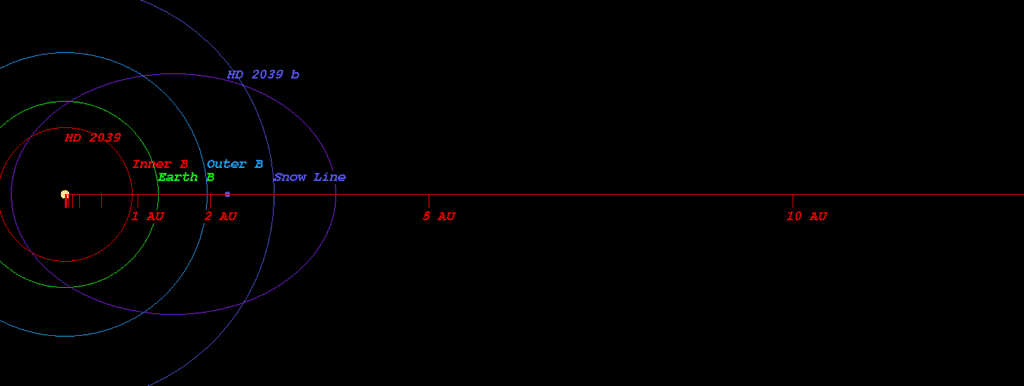
WASP-18
WASP-18 is a star located at around 404 light-years away from us, having an apparent magnitude of 9.273. This star is believed to host an exoplanet, but further observations are needed.

WASP-4
WASP-4 is a G-type main-sequence star located at around 880 light-years away from us. It has an apparent magnitude of 12, and it is much smaller and less massive than our Sun. A hot-Jupiter type of planet is orbiting this star.

WASP-5
WASP-5 is a yellow dwarf star located at around 1,020 light-years away from us. It has an apparent magnitude of +12.26, and it also hosts an exoplanet.

Mu Phoenicis
Mu Phoenicis is a yellow-white G-type star located at around 246 light-years away from us. It has an apparent magnitude of 4.59. This star has exhausted its hydrogen supplies, and it has cooled and expanded of the main-sequence.

Mu Phoenicis has around 250% of our Sun’s mass, 1,315% of its radius, thus it is 26 times larger than our Sun, and it Is 96.6 times brighter than our Sun.
Deep-sky Objects in the Constellation of Phoenix
The constellation of Phoenix hosts many interesting deep-sky objects, such as the irregular dwarf galaxy NGC 625, the lenticular galaxy NGC 37, the group of galaxies known as Robert’s Quartet, the HLX-1 luminous source, which is the first discovered intermediate black hole, the gigantic Phoenix Cluster, or the largest distant galaxy cluster ever observed, the El Gordo, among others. There are no Messier Objects in the constellation of Phoenix.
NGC 625
NGC 625 is a dwarf barred spiral galaxy located at around 12.7 million light-years away from us. It has an apparent magnitude of 11.7, and it is part of the Sculptor Group of galaxies.
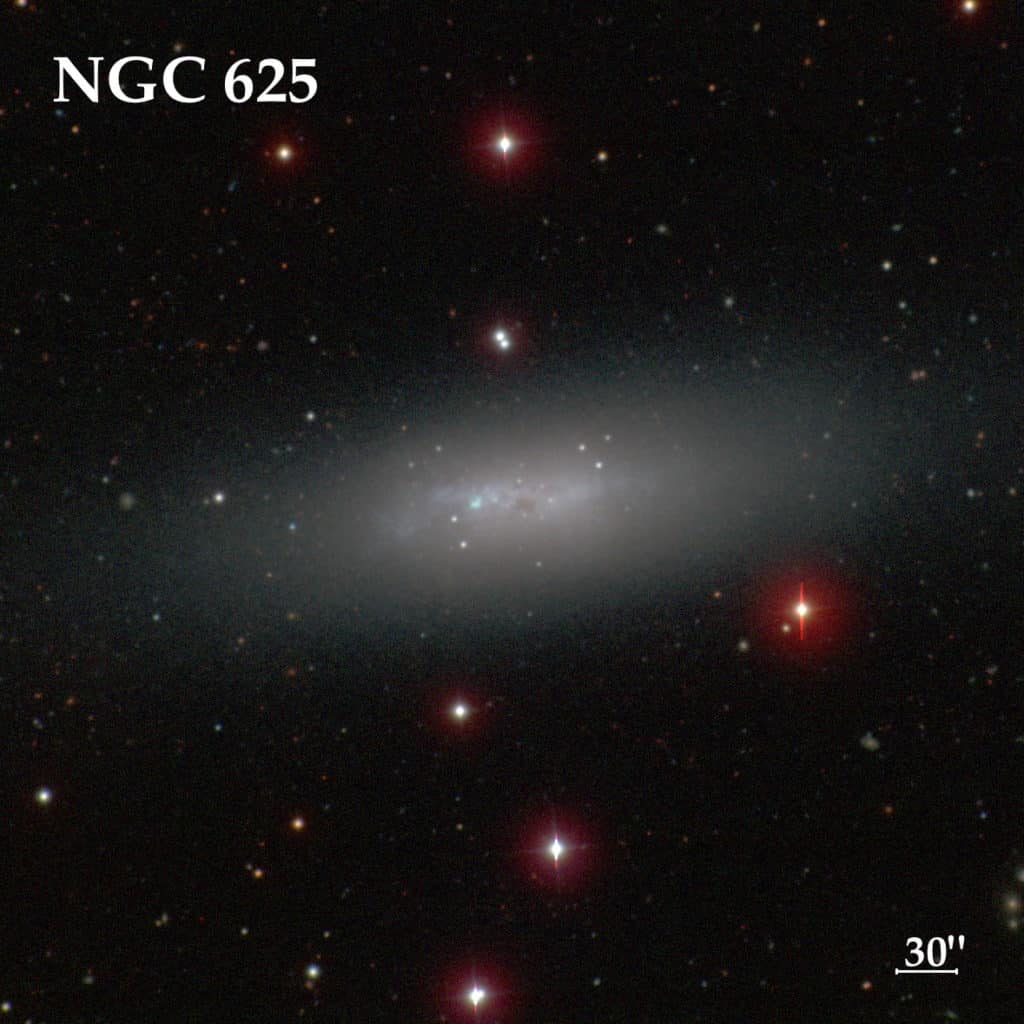
NGC 37
NGC 37 is a lenticular galaxy located at around 427 million light-years away from us. It has an apparent magnitude of 14.66, and it is 137,000 light-years in diameter. NGC 37 is estimated to be 12.9 billion years old.

Robert’s Quartet
Robert’s Quartet is a compact galaxy group located at around 160 million light-years away from us. It consists of the galaxies NGC 87, NGC 88, NGC 89, and NGC 92.
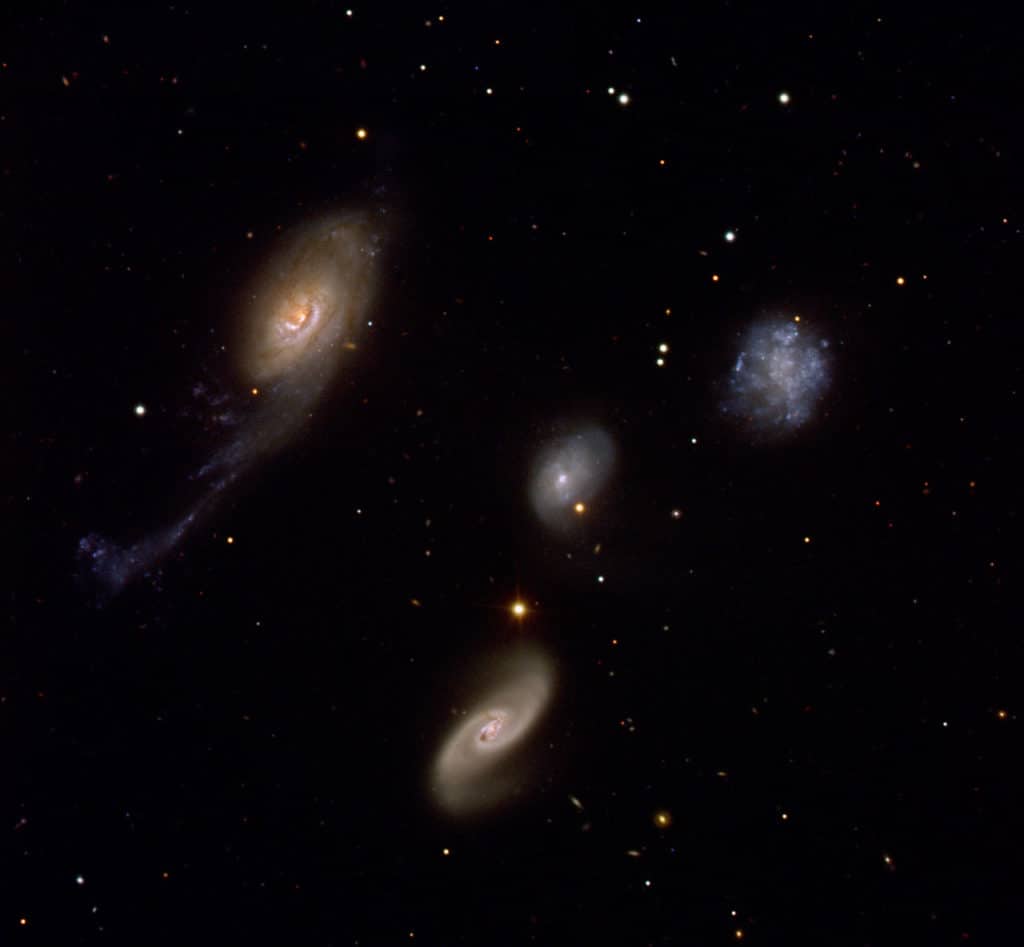
The brightest member of Robert’s Quartet is NGC 92, which is an unbarred spiral galaxy that has a magnitude of 13.81. NGC 88 is a barred spiral galaxy that has an apparent magnitude of 14.1, while NGC 89 is a lenticular galaxy with an apparent magnitude of 14.18. The last member, NGC 87, is an irregular galaxy, having an apparent magnitude of 14.1.
The Phoenix Cluster
The Phoenix Cluster is a massive type I galaxy cluster located at around 5.7 billion light-years away from us, in the constellation o Phoenix.
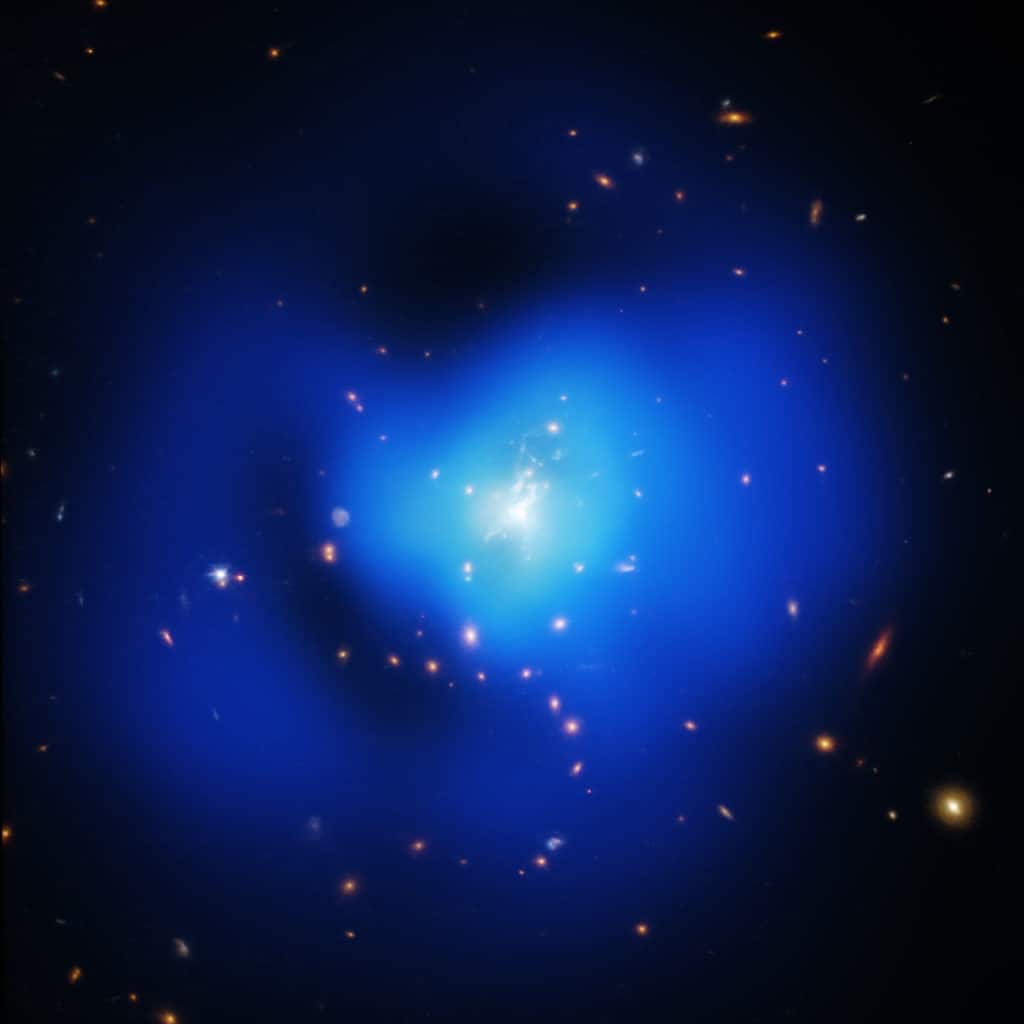
It is among the most massive galaxy clusters ever observed. The vast stellar halo of its central galaxy extends to over 1.1 million light-years from the center, making it one of the largest galaxies known. The Phoenix Cluster is producing more X-rays than any other known massive cluster.
HLX-1
HLX-1, known as the Hyper-Luminous X-ray source 1, is an intermediate-mass black hole candidate, located in the lenticular galaxy ESO 243-49, which is around 290 million light-years away from us. This is the first intermediate black hole discovered.

El Gordo
El Gordo, translating to “The Fat One” or “The Big One”, is the largest distant galaxy cluster ever observed. It is located in the constellation of Phoenix, and it is located at more than 7 billion light-years away from us. El Gordo has a mass of around 3 quadrillion Sun’s.

Meteor Showers Associated with the Constellation of Phoenix
The constellation of Phoenix is associated with two meteor showers, namely the December Phoenicids, and the July Phoenicids. The December Phoenicids peaks around 4-5 December, almost every year, and it is thought to be the breakup of the short-period comet 289P/Blanpain.

The July Phoenicids is a minor meteor shower, that peaks around July 14, with around one meteor an hour at its zenith, though meteors can be seen anytime from July 3 to July 18.
Did you know?
- The constellations of Phoenix, Grus, Pavo, and Tuscana, are known as the Southern Birds.
- The HE0107-5240 star in Phoenix has around 1/200,000 the metallicity of our Sun, strong evidence that it must have formed very early in the history of our universe.
- De Houtman included the constellation of Phoenix in his southern star catalog under the Dutch name “Den voghel Fenicx” – “The Bird Phoenix” – symbolizing the phoenix from classical mythology.
- Unlike most of the Plancius constellations, Phoenix has actual precedent in ancient astronomy, such as in Arabic astronomy, where the constellation was seen as “young ostriches” – “Al Ri-al” – or as a giraffe, and even an eagle.
- The same group of stars in Phoenix was seen by the Arabs as a boat “Al Zurak” – on the nearby river Eridanus.
- The Chinese grouped Ankaa, and some bright stars from the constellation of Sculptor, to depict Bakui – a net for catching birds.
- Phoenix and the constellation of Grus were seen by Julius Schiller as portraying Aaron the High Priest.
Sources:
Image Sources:
- https://i.pinimg.com/originals/72/eb/6e/72eb6e31cb727c6bfe49194c9f797ac6.png
- https://starregistration.net/media/wysiwyg/Constellations/Phoenix.png
- https://upload.wikimedia.org/wikipedia/commons/thumb/b/b5/Johann_Bayer_-_Uraniometria_-_Southern_Birds.jpg/838px-Johann_Bayer_-_Uraniometria_-_Southern_Birds.jpg
- https://in-the-sky.org/images/constellations/con_PHE_000.png
- https://www.universetoday.com/wp-content/uploads/2008/12/phoenix-1280×720.png
- https://osr.org/wp-content/uploads/2016/08/alpha-phoenicis-star.jpg
- https://mw1.google.com/mw-planetary/sky/skytiles_v1/122_82_7.jpg
- https://lh3.googleusercontent.com/proxy/XnksY20OO3Zk6nZ8uLFsJQkairA7FH8Lsg5RrM-EHXLUMNqiYBXQ5OTOezoRANSzbC4wxOUFJtCuIC99x24Nf8QMuBXZhuglRB-pjzdHM-bYj0-sPrW7TIuDAk2GhwsrRjyqv1T-_mnq2-xJM3DrbWP9WQhTGmv9xQLhNVa6_4PJ9cG_njmrhMlVeaK03lcQi2Uzh_6jXVGw1_wW7lQB7k6iMCLvvYw76uX-c-nicPTSlTA
- https://theskylive.com/sky/stars/finder-charts/kappa-phoenicis-finder-chart.png?c=1586740773
- https://theskylive.com/sky/stars/star-images/3/338_800.jpg
- https://theskylive.com/sky/stars/finder-charts/nu-phoenicis-finder-chart.png?c=1586840395
- https://upload.wikimedia.org/wikipedia/commons/thumb/a/aa/Heic1323a_-1243686232.jpg/782px-Heic1323a_-1243686232.jpg
- https://upload.wikimedia.org/wikipedia/commons/d/d4/Eso0228a.jpg
- https://cdn.mos.cms.futurecdn.net/y6YnefnhWL5jPMkthNwgSM.jpg
- https://newsmedia.tasnimnews.com/Tasnim/Uploaded/Image/1396/11/12/1396111218010733913196144.png
- http://www.exoplanetkyoto.org/exohtml/HD_142_A_b_Orb.png
- http://www.exoplanetkyoto.org/exohtml/HD_2039_b_Orb.png
- https://upload.wikimedia.org/wikipedia/commons/3/37/Planet_WASP-4.png
- https://i.pinimg.com/originals/be/44/8d/be448d89a88ccac40239a6d02f078f82.jpg
- https://theskylive.com/sky/stars/star-images/3/370_800.jpg
- https://cgs.obs.carnegiescience.edu/CGS/data/images/NGC0625_color.jpg
- https://telescopius.com/img/dso-images/builtin/NGC37-ngcicproject.jpg
- https://cdn.eso.org/images/screen/eso0535a.jpg
- https://upload.wikimedia.org/wikipedia/commons/3/3a/SPT-CLJ2344%E2%80%934243_%28Phoenix_Cluster%29_Chandra.jpg
- https://upload.wikimedia.org/wikipedia/en/e/e3/Hyper-Luminous_X-ray_source_1.jpg
- https://upload.wikimedia.org/wikipedia/commons/thumb/a/a7/ACT-CL_J0102%E2%88%924915.jpg/994px-ACT-CL_J0102%E2%88%924915.jpg
- https://www.amsmeteors.org/wp-content/uploads/2016/11/fireball2.jpg
